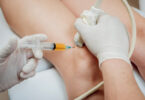[et_pb_section bb_built=”1″][et_pb_row][et_pb_column type=”1_2″][et_pb_text _builder_version=”3.13.1″]
The bandages are reinforcements or containments made with a material indicated for it, in order to wrap an injured limb or other parts of the human body.
In First Aid they are used especially in case of wounds, hemorrhages, fractures, sprains and dislocations.
The types of bandages on a part of the body have preventive or therapeutic purposes and have the following objectives:
Compression
To stop bleeding, encourage the absorption of tissue fluids and prevent the loss of these.
Contention
To limit movements of extremities or joints in cases of dislocation, sprain or fracture, hold healing material and provide heat and protection.
Correction
To immobilize a part of the body and correct deformities.
Circular
Used to fix the initial and final end of an immobilization, to fix a dressing and to start and / or end a bandage. It is used in places of not very large width such as the wrist, arm, leg, foot and fingers of the hand.
Spiral
Usually used in the extremities; each turn of the band covers partially (2/3) of the previous turn and is located somewhat obliquely to the axis of the tip. Elastic bandage is usually used because it adapts better to the area to be bandaged. It is used to bandage a part of the body that is uniform in circumference.
In 8
It is used in the joints (ankle, knee, wrist and elbow), since it allows them to have some mobility.
Spike
It is done by holding the bandage roll with the dominant hand and going up. We will always start at the most distal part.
Velpeau
It is used for scapular waist injuries. The arm is placed along the thorax with the elbow in flexion and the hand higher than the elbow.
[/et_pb_text][/et_pb_column][et_pb_column type=”1_2″][et_pb_text _builder_version=”3.13.1″]
Recurrent return bandage
It is used on the tips of the fingers, the head and stumps.
There are several types of bandages among them we can name the following:
The elastic bandage provides a uniform and smooth compression on the tissue surrounding an injury, to reduce pain and inflammation. You may need an elastic bandage for any of the following reasons:
To improve circulation (flow) of blood to any extremity of the body.
To wrap a limb that is splinted, while improving
To keep the dressings in place
To hold hot or cold compresses in place.
Elastic bandages come in different sizes and lengths. These could include metal clasps or tape to hold the bandage in place.
Some suggestions of safety and comfort
Do not tighten the bandage very tightly because it can stop the flow of blood.
Remove the bandage at least 2 times a day. Let a few minutes pass before wrapping the bandage again. Ask the doctor if you should remove the bandage at night.
Remove the bandage if you have numbness or tingling, or your extremity becomes cold or pale. Gently rub the skin. Wrap the bandage again when this area feels better.
Wash the bandage every day or when it is loose. Keep an extra bandage in case the one you are using gets dirty or wet.
The cotton bandages are the ideal material to wrap a limb thanks to these it is possible to achieve a quick recovery. This is implemented as a resource to wrap an extremity or any part of the body that presents an injury or wound (also to prevent or prevent an infection).
As simple as these tips, is to acquire our services. Get to know your new Pharmamedic digital medical center.

[/et_pb_text][/et_pb_column][/et_pb_row][/et_pb_section]









